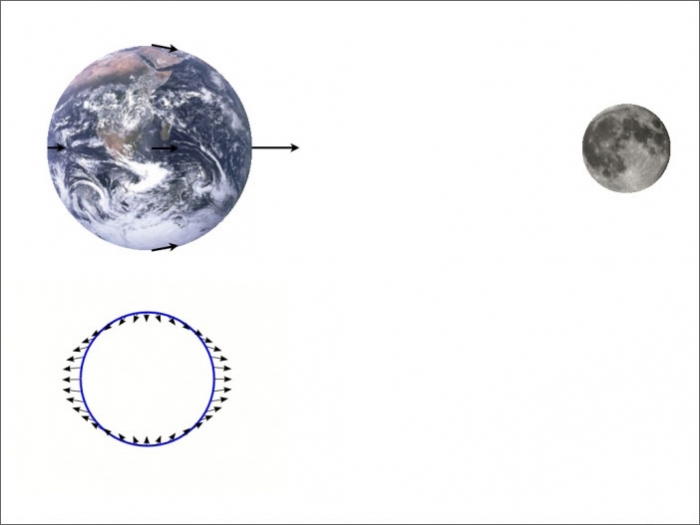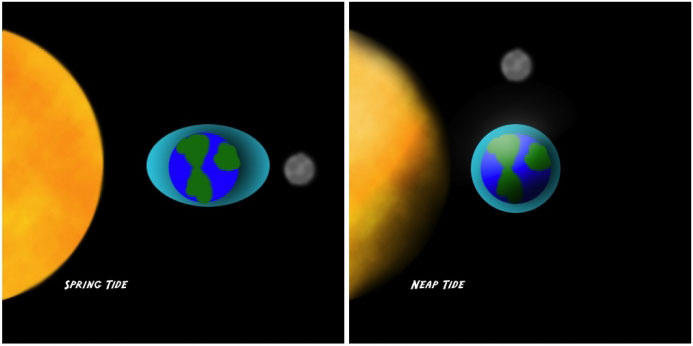Additional reading from www.astronomynotes.com(link is external)
The Earth and the Moon directly influence each other, so it is best to think of these two objects as part of one larger system, rather than two separate, individual objects. Compared to the Earth, the Moon is relatively large. It has 1% of Earth's mass, and has 1/4 the Earth's radius. The Earth and Moon can almost be considered a binary planet system. The most notable influence that the two objects have on each other is tides.
The figure below shows the force of gravity felt by the Earth from the Moon. It is strongest just below the Moon and weakest on the side of the Earth opposite from the Moon (as indicated by the arrows). After you subtract off the mean force, you are left with the schematic diagram of the Moon's differential gravity field on the Earth in the bottom of the image. This shows how the Moon tidally deforms the Earth, creating two areas of high tide per day. This effect is most noticeable as the oceans and other bodies of water respond to the Moon's gravitational tidal force. Below the Moon, ocean water, for example, gets pulled into a high tide. One way to think of the reason for the high tide on the opposite side of the Earth from the Moon, is that the water gets "left behind", because it isn't being pulled as strongly as the center of the Earth, so there is a high tide on that side, as well. On the two sides of Earth perpendicular to the Moon, the net effect is that the water gets squeezed towards the center of the Earth, causing low tides at these two locations. As the Earth rotates once around during a 24 hour day, each location goes through high tide, low tide, high tide, and low tide.

For an animation of this effect as the Moon orbits the Earth, see NOAA's animation of the tides(link is external), which is part of a detailed tutorial on the tides(link is external).
In the animation on the NOAA site, you can see how the Sun also contributes to the tides on Earth. The tidal force on the Earth from the Sun is weaker than the tidal force on the Earth from the Moon. The way we observe the effect of the Sun is that when the Moon is in its Full or New phase, the Sun enhances the tidal effect of the Moon, leading to higher high tides. These are called spring tides. When the Moon is at 1st or 3rd Quarter (i.e., the Sun/Earth line is perpendicular to the Moon/Earth line), the Sun's tidal force cancels some of the Moon's tidal force, leading to lower than normal high tides. These are called neap tides. The images below illustrate the difference between the two.

Check it out!
You should note that even though many images in textbooks and from reputable sources like NOAA show the tidal bulge of the Earth pointing directly at the Moon, the true behavior is that the bulge is not aligned perfectly with the Moon—there is a delay.
Tides in the Earth/Moon system have led to an effect called tidal locking, and the Moon is now in a synchronous orbit (its rotation period is equal to its orbital period around the Earth). This effect is common, and occurs in many other systems. In the case of the Earth/Moon, this is how it works:
- The tidal bulge on the Earth rotates as the Earth rotates, and in general, the high tide bulge doesn't point straight at the Moon like in the image above. Instead, as illustrated in the ClassAction animation, the Moon lags behind the bulge.
- The force of gravity from the Moon pulls the deformed Earth in the direction opposite to its rotation, causing the Earth's rotation period to slow down. You might remember this by thinking that the tidal bulge is shifting in order to line up with the object causing it.
- The Moon gets deformed by the Earth, too, although since there is no water on the Moon, the effect isn't as obvious. However, the tidal bulge on the Moon has already shifted so that it points directly at the Earth. This is why the Moon always points the same face to the Earth.
- Because of Newton's third law (equal/opposite reaction), as the Earth slows down because of the Moon's pull, the Earth is pushing the Moon slowly away from the Earth. It gets farther away from us year after year.
Summary
To summarize the Earth/Moon system, we find that the two are rocky objects with different densities. Both are differentiated, with different layers of different density material in the crust, mantle, and core. The Earth's crust changes over time (plate tectonics) and the Earth's atmosphere continues to evolve, too. The Moon's crust is mostly unchanged since the event that created the Maria, and its lack of atmosphere means that the surface is unlikely ever to change. The Earth and Moon directly influence each other through tides, and the Moon has actually achieved a tidal lock to the Earth, which causes it to keep one face permanently pointed at the Earth. We will find that the other planets in the inner Solar System share some of the properties of the Earth / Moon system, but each also has some of its own peculiarities.
We should expect that the phenomena and the processes that influenced the Earth and the Moon during their evolution should have also influenced the other planets, as well. For example, tidal locking is observed in other parts of the Solar System (and other solar systems and star systems), too.